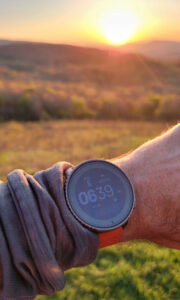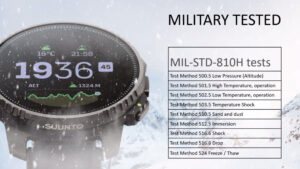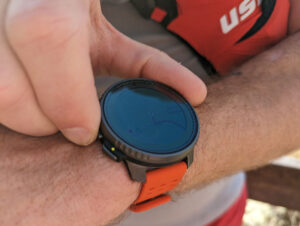
The Suunto Vertical is the first watch built on Suunto's UI that has on-board maps. (Image by Ryan Tipps)
The Vertical naming convention is fitting as this watch is likely to do much to elevate Suunto’s place in the adventure market.
With offline maps, dual-band GNSS and solar functionality, the Suunto Vertical sports watch debuts as the most advanced and dynamic wearable this adventure brand has ever produced. The launch of the Vertical — which also incorporates market-leading battery power and a stylish durable design — pushes the boundary of features and functionality well beyond most of the 9 Series and continues a welcome renaissance for the Finnish company.
The Vertical will be available from retailers on May 16 and is the first watch Suunto has released since October, when the compact 9 Peak Pro became available. In a nod to Suunto’s forward-thinking sustainability initiatives, the new watch is fully carbon compensated and is made in Finland with renewable energy.
The Vertical’s 49 mm case lands in the sweet spot between the minimalist 9 Peak Pro and the bulkier 9 Baro, and its 1.4-inch MIP display screen is the largest Suunto has ever had. The Vertical is available in various colors for both steel and titanium models (at 86 grams and 74 grams, respectively), with the titanium being the ones with solar capability. All versions come with 22 mm quick-release straps.

The Suunto Vertical is shown the morning of a ultramarathon in the Virginia highlands. (Image by Ryan Tipps)
In creating the Vertical, Suunto explored the issues that were most pressing from its primary audiences of outdoor adventurers, outdoor athletes, and the dive community.
“We found that outdoor adventures can many times be dangerous. They happen in harsh conditions, and they are physically demanding. So there were three clear areas where we could do some stuff,” said Markus Kemetter, a Suunto product manager.
New in the Vertical
While offline maps were found in the Suunto 7 smartwatch, which was built on Google’s Wear OS platform, this feature along with dual-band and solar capabilities are woven into Suunto’s UI for the first time — and they are game-changing to the company’s competitiveness in the market. From features and functionality to styling and visibility, this one release silences many of the verbal volleys that critics have lobbed at Suunto in recent years.
“The screen is really good on this watch. I think it’s better than any other Memory In Pixel watch that I’ve used,” said Bradly Olwin, a longtime unpaid Suunto tester who has been using the watch for the past few months. “It’s definitely brighter than the other models.”

From left: Suunto Vertical Titanium, 9 Peak Pro Titanium, 9 Baro and 5 Peak.
And the balance between tracking accuracy and battery life is staggering, especially considering how well it performs with dual-band enabled.
When beginning an activity, the Performance setting ushers in dual-band, which means that not only are all five major satellite systems being used (GPS, Galileo, GLONASS, Beidou and QZSS) but also that it uses two of the three available civilian GNSS frequencies: the L5 signal in addition to L1, helping to minimize disruptions due to reflections off of buildings and mountains.
And this has led to improved accuracy in many testing environments.
Brand comparison data presented by blogger the5krunner showed the Suunto Vertical earning the best GNSS accuracy score from any watch ever, topping such devices as the Garmin Epix 2, the Coros Apex 2 Pro and the Garmin Forerunner 955.
“It’s one of the best on the market — if not the best on the market — when it comes to battery life with this level of accuracy,” Kemetter said of the Vertical. “You don’t need to compromise.”
A step down from Performance mode, the Vertical’s Endurance setting for activities is actually identical to the best setting that has been available in the 9 Peak Pro: all-systems GNSS at one-second tracking.
When using solar capabilities on the titanium models, three hours a day at 50,000 lux increases the battery life anywhere from 40 percent to 100 percent, depending on the activity setting. And a widget serves as an instant charging indicator to show exactly how well the Vertical is responding to the sun.

In a smaller case size, the Suunto Vertical packs more battery power than its main competitors. (Image by Ryan Tipps)
So how good of battery life are we talking about?
With dual-band and all-systems GNSS enabled on Performance mode, the Vertical lasts for 60 hours. During a video call, Kemetter said that lab tests actually showed that number to be markedly higher, but the company chose to be restrained in their marketing to ensure real-world integrity. Factoring in three hours of direct sunlight per day, the battery life rises to 85 hours. (By comparison, the Garmin Enduro gets 50 hours in dual-band and 65 with solar, while the Coros Vertix 2 gets 50 hours; both watches have larger case sizes and sit chunkier off the wrist than the Vertical.)
“The solar is incredible,” said Olwin, who has bought competing watch brands in recent years to help with comparisons. “The panel inside it is much more efficient than Garmin’s.”
Beyond the top-tier Performance mode, the Endurance mode (all-systems GNSS with single band and one-second intervals) allows for 90 hours of tracking, or as much as 140 hours with solar. Ultra mode gives 140 hours (280 hours with solar) with one-second and all-systems enabled but at 50 percent power, while Tour mode is made for those weeklong hikes with 500 hours of tracking at two-minute logging intervals.
As in previous Suunto watches, the battery mode can be changed on the fly, which is particularly valuable if an activity is taking longer than anticipated.
Basic time mode allows for 30 days (60 days with solar), using continuous heart-rate tracking. One great feature carried over from the 9 Peak and 9 Peak Pro was fast charging, which gives the wearer 10 hours of training with GNSS after just 10 minutes of charging times.
The onboard, offline mapping capabilities are likely to be one of the most celebrated pieces of the Vertical, and it’s a feature that fits comfortably into Suunto’s navigation heritage.
Free topographical maps for anywhere in the world can be downloaded to the watch over WiFi — the watch has 32 GB of space reserved specifically for maps. Those maps include trails, contour lines and water features, but as of yet, they aren’t labeled (this is something that is expected to arrive at a later date).
There are three different map styles that are environmentally situational: the Outdoor setting is the default, High-Contrast is made for particularly bright conditions, and Dark mode is used when minimal light is needed. Users can navigate the maps using either the touchscreen or the buttons, so it complements adventurers who wear gloves during activities.
“The maps are really easy to use,” Olwin said. “You push the button for a short press to zoom in and a long press to zoom out. And when you are using maps, that is probably one of the most convenient features I can think of.”
As with previous generations of Suunto products, navigation with pre-planned routes (the Suunto App does this better than any of its competitors — using 3D satellite maps, surface types, community sport heat maps and avalanche terrain maps) and breadcrumb tracking can always be seen. The Vertical also has traditional POI and compass bearing information available.
“I think the maps are faster and easier to read than Garmin’s maps,” Olwin added, though the difference is that Suunto’s maps are not re-routable from the watch itself.
Recently, a Suunto tester from Italy joined Olwin to do the grueling Rim 2 Rim 2 Rim trail run in the Grand Canyon.
“I used the Vertical with no issues. I had a route loaded, had maps, no problems at all,” he said. “And we were switching back and forth between the different map types. That was really cool. The High Contrast map worked really well in the Grand Canyon, because there’s no vegetation, but if I’d be in a mixed environment, I’d probably use the Outdoor mode.”
What Else is Behind the Glass?
For starters, the glass is sapphire crystal as standard, which has long been one of the cornerstones across Suunto’s flagship product line.
As with the 9 Peak Pro last year, Suunto adopted military-grade testing moving foward as a way to get third-party confirmation of what it was already seeing through in-house testing (Kemetter has previously told ActionHub that Suunto’s own testing is more rigorous than military testing and that their watches pass the tests easily).
The Vertical is built to operate from at least -5 degrees to +130 degrees Fahrenheit. It is also rated water resistant to 100 meters and is rated to 10 meters for snorkeling and mermaiding.

One exciting change for those users who discovered an obsession with barometric and weather activity thanks to Suunto devices: The new watch continues to have a barometer and a barometer-based storm alarm, but it also adds current weather and forecasting features directly onto the watch. The weather syncs every hour with the Suunto App without the user needing to do anything, and it shows the forecast for the next eight hours. The watch also includes air-quality readings that are based off of European standards.
Currently the day’s weather forecast is not something that shows up on the morning wakeup notification screen, but it is a feature that Suunto is considering for future firmware releases.
Overall, the UI is the same as what was seen in the 9 Peak Pro (which was widely accepted as faster and more visible than previous generations), though the widget screens have been revamped somewhat. (The 9 Peak Pro will get things like the weather feature as well as a flashlight function — white screen at 100 percent brightness — and older Suunto watches will get more modest updates based on their hardware and memory.)
The Vertical carries over the optical heart rate sensor that was in the Suunto 9 Peak Pro, which the company says is within 5 percent of a chest-measured heart rate about 90 percent of the time.
“One of the things I really like is the intensity ring: for heart rate, pace or power,” Olwin said. “I do a lot of ultras, but I never put my heart-rate number in any field. I have no need for it. On the Vertical, I can look at the ring and get instant feedback to see what zone I’m in. I can monitor my relative effort very, very easily.”

The Suunto Vertical is a watch made for the mountains. (Image by Ryan Tipps)
The watch is preloaded with more than 90 sport activity modes, which does well to fit the catchphrase that it’s “made for (m)any sports in any conditions.” And because of the Vertical’s larger size, the 7 custom data fields that can be used during an activity show up nicely.
Suunto has also been aggressively partnering with third-party outdoors companies to create a suite of SuuntoPlus Apps for their wearables, and while some of the early ones included Strava Relative Effect and Ghost Runner, today there are more than 50 available, such as Race Time, Drinking Reminder and Circuit Training timers. For the first time in a Suunto device, the Vertical allows for two SuuntoPlus Apps to run simultaneously.
The Suunto Vertical is being priced at $629 for the steel version and $839 for the titanium version. Early this year, the company implemented a new pricing structure across its line of wearables, making them noticeably more competitive in the tech market.
“It amazes me the work that goes into Suunto thinking about how you’ll actually use a feature,” Olwin said. “They’ll implement something, and I’ll go, ‘Wow, I didn’t think through how I’d actually use this, and had I used it on my own, I’m not sure I would have thought of how to implement this so well to really make it usable like Suunto has.’”
After Action Report
Although Suunto was purchased by China-based Liesheng in 2022, more than 90 percent of its products are still manufactured in their facility in Vantaa, Finland. The sales and design teams also continue to work from there.
Interestingly, this giant leap for Suunto was a project that began even before the ownership change. Yes, Liesheng brought some resources to the table that Suunto did not have before, but the concept and plan for this new sport watch had already been in place.

Suunto’s market-leading route creation tool can now be applied to maps rather than just breadcrumb trails. (Image by Gretchen Tipps)
It will be exciting to see how Suunto showcases the Vertical. The company intends to be at some flagship industry events like The Big Gear Show, and it also plans to partner with Ragnar Relays to have the watch featured at all of the series’ 2023 races. For a tech brand that has long been focused on off-grid and more extreme adventure, it’s easy to foresee Suunto permeating a broader sports market with these kinds of outreach efforts.
I’ve used the Vertical for a couple of weeks, and in that time, I have done multiple hikes and trail runs, including a 50k race in unfamiliar territory. As the course criss-crossed itself and even overlapped at times, I used the onboard maps extensively to confirm my location and to ensure I was staying on the preloaded course map.
Using this device comes after I’ve worn the 9 Peak Pro for several months, and it’s been interesting to compare the GNSS tracking between these two top-tier devices.
The 9 Peak Pro employs all-systems GNSS tracking, and I was wholly impressed with its measurements — both on paved greenways where I could see my route and on out-and-back trail runs, where I frequently analyze how the segments lay on top of each other.
With the Vertical, what was already great tracking realistically got even better. Dual-band has long been seen as the holy grail of tracking accuracy for sport watches — and that checks out. I’ve seen even tighter tracks, and my measurements align with known distances on even the most uneven and winding trails.

Ryan Tipps navigates using a Suunto Vertical during an ultramarathon in Virginia. (Image by Gretchen Tipps)
As a distance runner, a few seconds here or there, or even a turn in a trail getting slightly cut off, typically doesn’t matter much in the grand scheme of things. But the Vertical has dispelled many reservations I had about dual-band and whether such a feature would impact how I used the watch or whether I worried about battery life. I’m confident using its full capabilities for mapping, routing and SuuntoPlus Apps during an activity. And I am particularly eager to use the on-watch weather data regularly.
On top of all of that, this is my favorite Suunto ever from a design perspective. The casing and bezel look great, the buttons are easy to use, the size is right in my sweet spot as a trail runner, and it sits comfortably on my wrist.
Re-establishing the use of the Vertical naming convention, which harks back to the Ambit3 Vertical from the mid 2010s, is fitting as this watch will do much to elevate Suunto’s place in the adventure market.
“Being founded in 1936, there’s a huge amount of heritage that Suunto brings to the outdoor adventure world, that we are super keen to maintain and honor as we go into the next generation of products for adventure and outdoorsmen,” said Craig Lees with Huish Outdoors.

Ryan Tipps is Managing Editor for ActionHub. He lives along the Blue Ridge Mountains, is an avid hiker, backpacker and trail runner and has been a part of the wilderness search and rescue community since 2005.
 Your Privacy Choices
Your Privacy Choices
 The
The